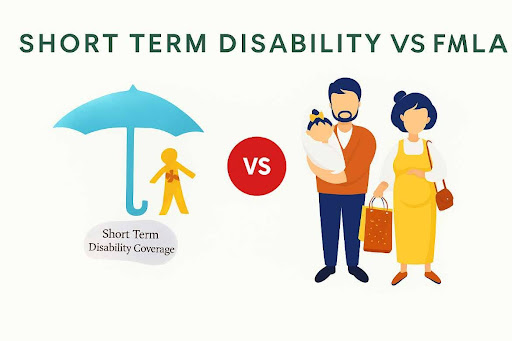When it comes to taking time off work due to illness, injury, or family-related reasons, two options often come into play: short-term disability (STD) and the Family and Medical Leave Act (FMLA). While both provide important benefits, they serve different purposes and have distinct requirements. If you’re trying to navigate these two leave options, you’re not alone! This blog will help you understand the key differences between short-term disability vs FMLA and how they can work together or separately to meet your needs.
What is Short-Term Disability (STD)?
Short-term disability provides income replacement if you’re temporarily unable to work due to an illness or injury. Unlike FMLA, which guarantees job protection but doesn’t provide pay, STD ensures you can still receive a portion of your salary while you’re away from work.
What Does Short-Term Disability Cover?
Short-term disability typically covers illnesses or injuries that prevent you from doing your job, whether it’s due to an accident, surgery, or a serious health condition. For example, if you undergo surgery and need time to recover, STD can provide you with income for the duration of your recovery, typically ranging from a few weeks to up to a year, depending on your policy.
How Does Short-Term Disability Differ from Other Leave Types?
One of the biggest differences between STD and other types of leave is that STD offers income replacement, whereas many other leave options (like unpaid time off) do not. This makes STD particularly helpful when you need time off but can’t afford to go without pay.
Also Read: Can You Be Fired While on Short-Term Disability?
What is FMLA?
The Family and Medical Leave Act (FMLA) is a federal law that allows employees to take unpaid, job-protected leave for up to 12 weeks in a 12-month period. Unlike short-term disability, FMLA does not provide income replacement. However, it ensures that you won’t lose your job while dealing with a personal medical issue, the birth of a child, or caring for a sick family member.
What Does the Family and Medical Leave Act (FMLA) Cover?
FMLA covers a wide range of situations, including:
- Personal health conditions: If you’re dealing with a serious illness or injury.
- Family care: If you’re caring for a family member with a serious health condition.
- Parental leave: If you’re welcoming a new child through birth, adoption, or foster care.
FMLA is a federal guarantee for many workers, but not everyone qualifies, and it’s important to understand the specific criteria.
Who is Eligible for FMLA?
To qualify for FMLA, you must meet the following criteria:
- You must have worked for your employer for at least 12 months.
- You need to have worked at least 1,250 hours in the past 12 months.
- Your employer must have at least 50 employees within a 75-mile radius.
Key Differences Between STD and FMLA

Although short-term disability vs FMLA both provide time off for medical-related situations, they differ in key ways—mainly in terms of income and job security.
Income Replacement vs. Job Protection: What’s the Difference?
Short-term disability (STD) provides financial assistance by covering a portion of your wages when you’re unable to work due to a qualifying illness or injury. However, it doesn’t ensure that your employer must hold your job for you.
FMLA, on the other hand, guarantees that your position—or a similar one—will still be available when you return from leave. It does not, however, offer any form of income during your absence, which can be a challenge without other benefits in place.
How STD and FMLA Work Together: Can You Use Them at the Same Time?
In many cases, both STD and FMLA can be used at the same time, although they serve different purposes. FMLA offers job security, while STD provides partial income.
Many employers structure these benefits so that they are applied concurrently, meaning the time off you take may be counted under both programs if you qualify for each.
STD vs. FMLA: Duration and Coverage Explained
Short-Term Disability:
STD generally covers a medical leave period that may range from a few weeks up to a full year, depending on your employer’s policy and your health condition. The income provided typically ranges from 40% to 70% of your standard earnings.
FMLA:
FMLA gives qualified employees the right to take up to 12 weeks of unpaid leave within a single year while ensuring that their job—or a comparable role—will still be available upon their return.
How to Use STD and FMLA Benefits Together

If your medical condition requires extended time away from work, combining STD and FMLA can provide both financial support and job assurance.
Is It Possible to Use Both at Once?
Yes, in most scenarios, employees are allowed to receive short-term disability income while taking protected leave under FMLA. This combination ensures you have continued income while also keeping your job secure. It’s important to confirm how this applies to you by checking your company’s HR policy.
What If STD Ends Before FMLA?
If your short-term disability coverage ends before your FMLA leave concludes, you may still continue your absence under FMLA without pay. During this time, your job remains protected, but you may need to explore additional income sources like paid time off or state programs.
Eligibility Requirements for STD and FMLA
How Do You Qualify for Short-Term Disability?
STD eligibility is based on the specifics of your employer’s plan. Most require you to work with the company for a certain amount of time—like 30, 60, or 90 days—before benefits are available. In many cases, documentation from a healthcare provider is also required, and some plans include a short waiting period before payments begin.
What Are the Requirements to Qualify for FMLA?
To be considered eligible for FMLA leave, you must meet all three of the following criteria:
- You’ve worked for the organization for at least 12 months total (these months don’t have to be consecutive)
- You’ve logged a minimum of 1,250 work hours in the year immediately before your leave begins
- Your employer has a staff of 50 or more employees within a 75-mile radius of your work location
Common Misconceptions About STD and FMLA
I’ve come across many questions about short-term disability (STD) and FMLA, and some common misunderstandings keep popping up.
Is FMLA Always Paid?
No, FMLA leave is unpaid. It doesn’t provide wages while you’re away, but it does ensure your job will still be there when you return. However, you can often combine FMLA with other benefits like short-term disability or accrued vacation days to maintain income during your leave.
Does STD Guarantee Job Protection?
No, short-term disability does not protect your job. It replaces a portion of your income if you’re unable to work due to a qualifying medical condition, but your employer isn’t required to hold your job unless you also qualify for FMLA.
Frequently Asked Questions (FAQs)
What is Washington Paid FMLA (PFMLA)?
Washington’s Paid Family and Medical Leave (PFMLA) is a state-run benefit that offers eligible workers up to 12 weeks of paid time off while safeguarding their job during that period.
What’s the difference between FMLA, STD, and Washington PFMLA?
FMLA allows you to take unpaid time off from work with the assurance that your job will still be available when you return. STD helps cover part of your income but doesn’t guarantee job protection. Washington PFMLA offers both paid leave and job security under state law.
How is short-term disability in Illinois different from FMLA?
In Illinois, short-term disability benefits vary by employer and offer financial support during time off. FMLA, on the other hand, is a federal law that ensures your job is protected during unpaid medical or family leave.
Can I get paid while on FMLA?
FMLA doesn’t include pay. But you may be able to use STD benefits, vacation, or sick leave to receive income during your time off.
Can FMLA be used for pregnancy or childbirth?
Yes, FMLA can cover time off for pregnancy, childbirth, and postpartum recovery.
How do I apply for STD or FMLA?
You’ll need to notify your employer, provide required medical documentation, and follow your company’s leave procedures. Some employers also require you to apply through their benefits provider or HR portal.
Can I take FMLA to care for a sick family member?
Yes, the FMLA permits you to take job-protected time off to support a loved one dealing with a serious medical condition.
Wrapping It Up: Understanding Short-Term Disability vs FMLA
Understanding how short-term disability vs FMLA benefits work can help you prepare for medical or family-related leave with confidence. While FMLA is a nationwide regulation that grants eligible employees unpaid time off with job security, STD is a benefit typically offered by employers to help cover your pay during health-related absences.
Before making any decisions, take time to review your company’s policies and talk to your HR department. Being informed puts you in a stronger position when unexpected circumstances arise.




